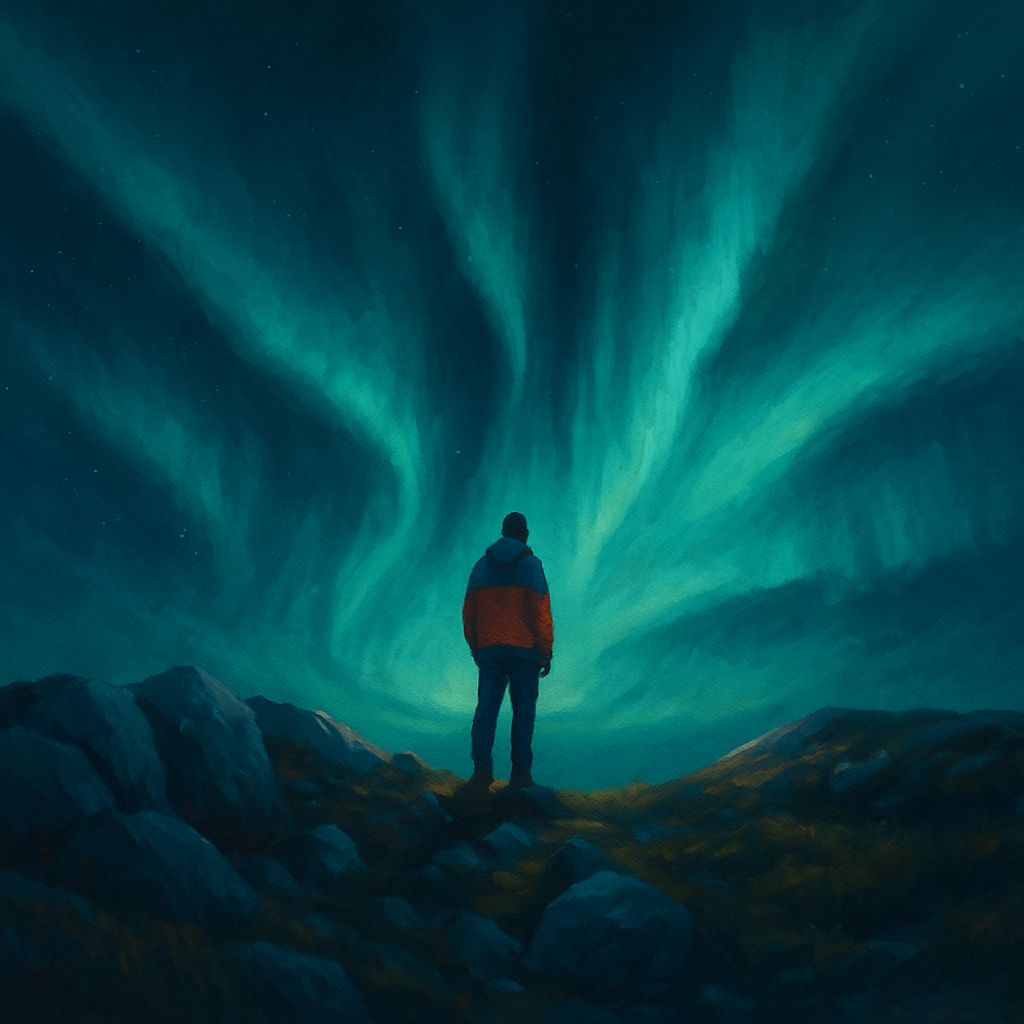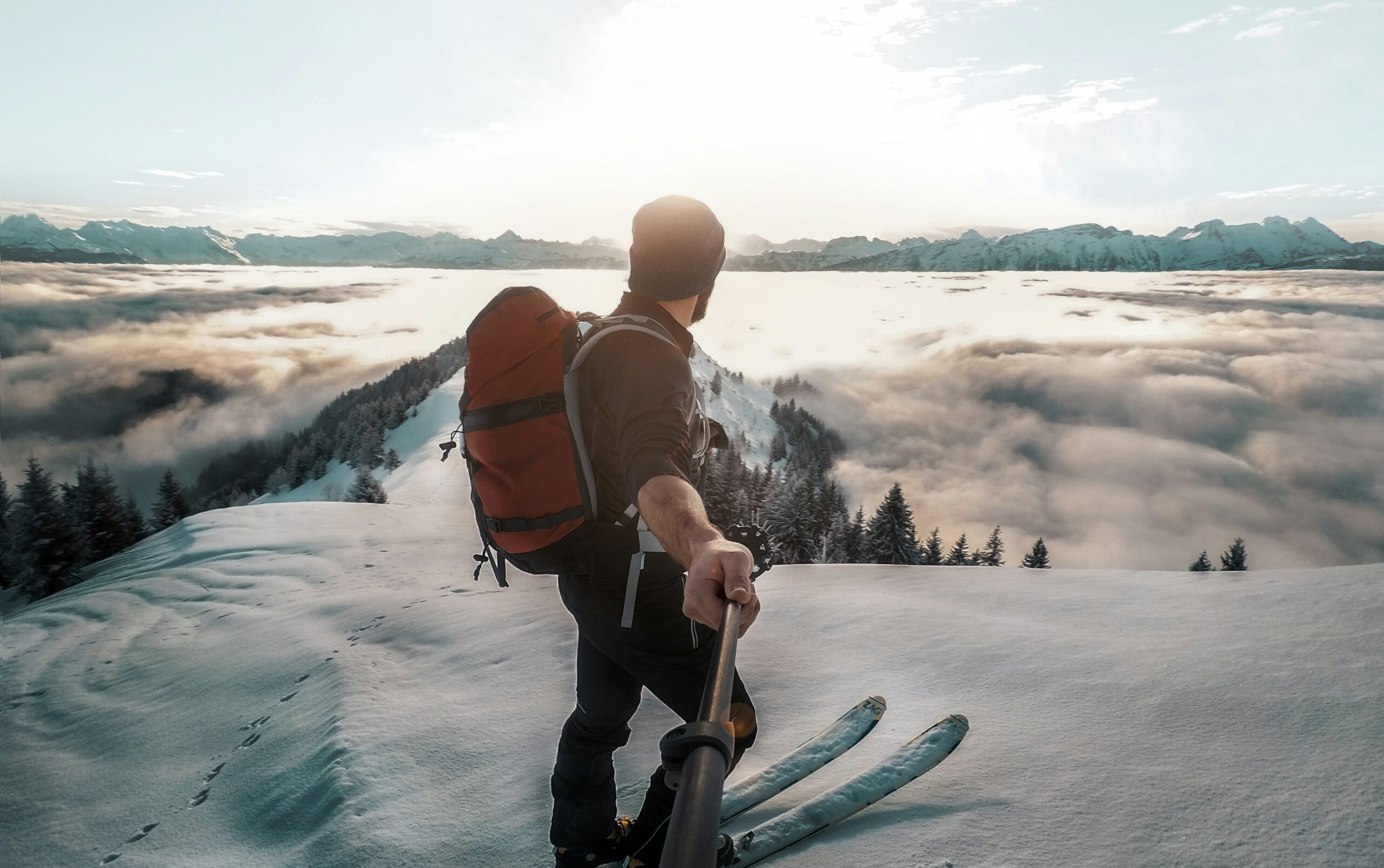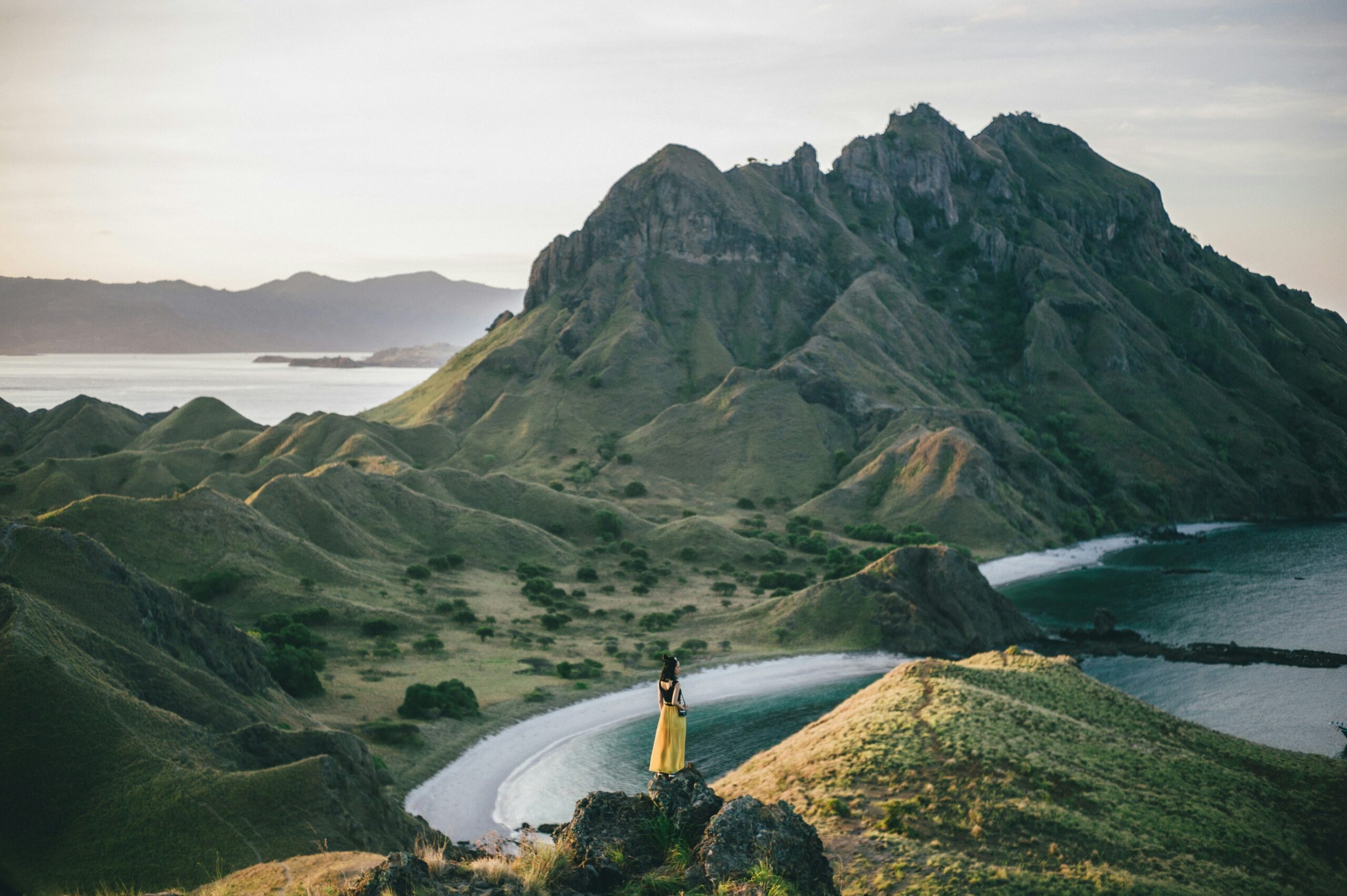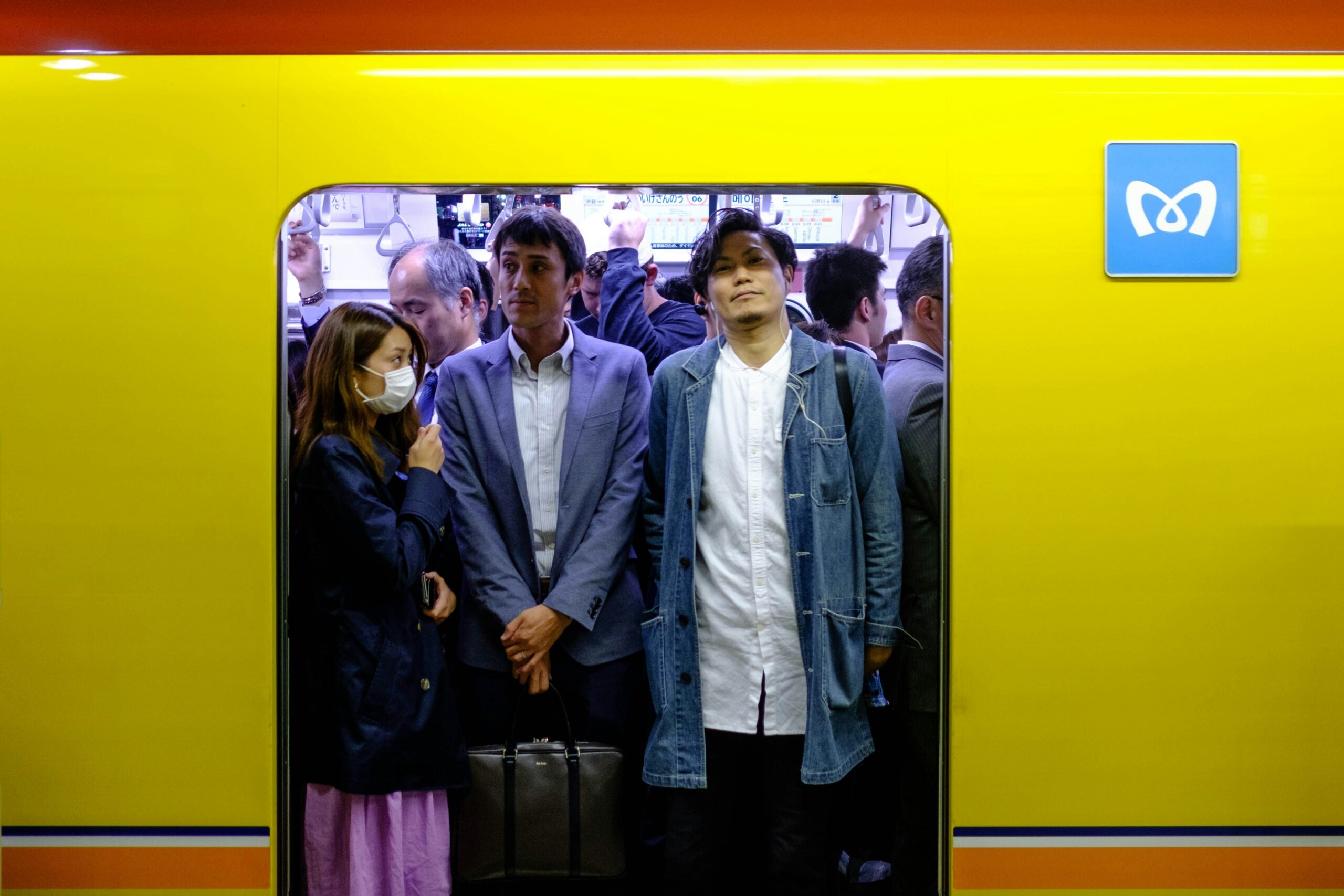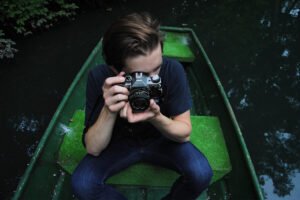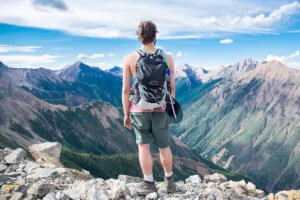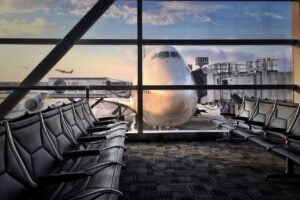Best Places to See the Northern Lights: A Complete Travel Guide to the Aurora Borealis
Standing beneath a sky painted with electric greens and vibrant purples is the kind of moment that makes you forget about the cold nipping at your fingers. The Northern Lights don’t announce themselves with fanfare. They simply appear, rippling across the darkness like silk catching wind, and suddenly nothing else matters.
I’ve chased auroras across three continents, and I can tell you this: seeing them requires more than luck. It takes planning, patience, and knowing where to look. This guide breaks down everything you need to know about witnessing the Aurora Borealis, from the best destinations to practical tips that’ll save you from frozen camera batteries and missed opportunities.
What Exactly Are the Northern Lights?
The Aurora Borealis happens when charged solar particles collide with gases in Earth’s atmosphere, creating those mesmerizing light displays. The closer you travel to the Arctic Circle, the better your odds. But here’s what most guides won’t tell you: proximity isn’t everything. You also need solar activity, clear skies, and true darkness.
That’s where technology becomes your best friend. Apps like My Aurora Forecast and Aurora Alerts send real-time notifications based on solar activity levels (measured on the KP index from the NOAA Space Weather Prediction Center). When that number hits 3 or above, it’s time to bundle up and head outside.
When Should You Go?
The aurora season runs from late September through early April, when polar nights are longest. November through March offers the most consistent viewing, though September and March have milder weather if you’re not keen on extreme cold.
Your best viewing window each night? Between 10 PM and 2 AM, when geomagnetic activity typically peaks. Avoid planning trips around full moons, which wash out the display. Instead, aim for new moon phases when the sky is at its darkest.
Iceland: Where Fire Meets Ice Under Dancing Skies
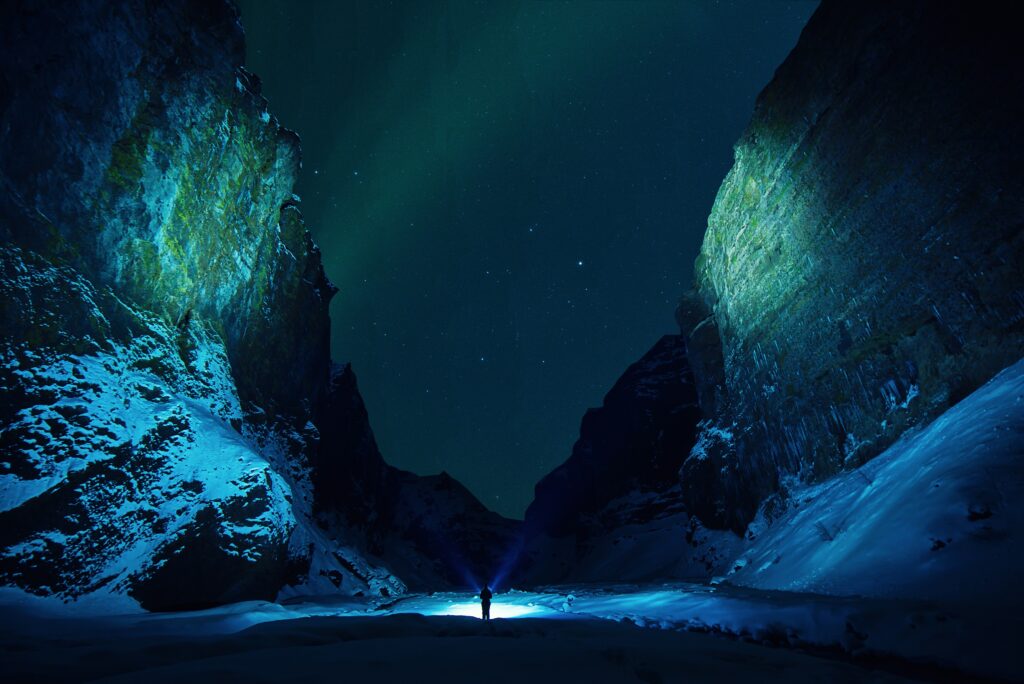
Iceland has become synonymous with aurora hunting, and for good reason. The entire country sits just below the Arctic Circle, offering extraordinary accessibility compared to more remote northern regions. Add in dramatic landscapes, from volcanic beaches to glacier lagoons, and you’ve got the perfect backdrop for aurora photography.
Where to Watch in Iceland
Thingvellir National Park sits 45 minutes from Reykjavík and delivers wide-open horizons with minimal light pollution. This UNESCO World Heritage site is where the North American and Eurasian tectonic plates meet, creating a dramatic rift valley that’s spectacular by day and hauntingly beautiful under the auroras.
Jökulsárlón Glacier Lagoon on the south coast offers something extraordinary: auroras reflected in water studded with floating icebergs. The contrast between ancient ice and celestial light creates images that don’t look real.
Snaefellsnes Peninsula remains less crowded than the Golden Circle while delivering incredible variety: volcanic craters, lava fields, and black sand beaches. The Kirkjufell mountain here is one of the most photographed aurora locations worldwide.
Practical Information for Iceland
Icelanders speak excellent English and welcome visitors warmly, though prices reflect the island’s remote location. Budget €150-200 daily for accommodation, meals, and activities. The Icelandic króna (ISK) is the local currency, but credit cards work everywhere, even for small purchases.
Food tends toward hearty and warming. Try plokkfiskur (fish stew), lamb soup served in bread bowls, and skyr, Iceland’s protein-rich yogurt that locals have eaten for over a thousand years. Fresh cod and Arctic char appear on most menus, prepared simply to highlight their quality.
Fly into Keflavík International Airport (KEF), where airlines like Icelandair, Play, and WOW air offer competitive transatlantic rates. The airport sits 50 km from Reykjavík, connected by regular buses or rental cars.
Speaking of cars: rent a 4×4 if visiting between November and March. Winter roads can be treacherous, but Iceland maintains them well. Download Vedur.is for detailed weather forecasts and road conditions. SafeTravel.is provides safety information crucial for winter driving.
Where to Stay
Base yourself in Reykjavík for easy access to tours and amenities, or choose accommodation along the south coast near Vik for darker skies. Many guesthouses and hotels offer aurora wake-up services when the lights appear.
For digital nomads, Reykjavík has excellent coworking spaces like Greenhouse and KLAK Coworking. Internet speeds are exceptional even in rural areas, making Iceland surprisingly workable if you’re planning an extended stay.
Norway: Arctic Sophistication Meets Wild Beauty
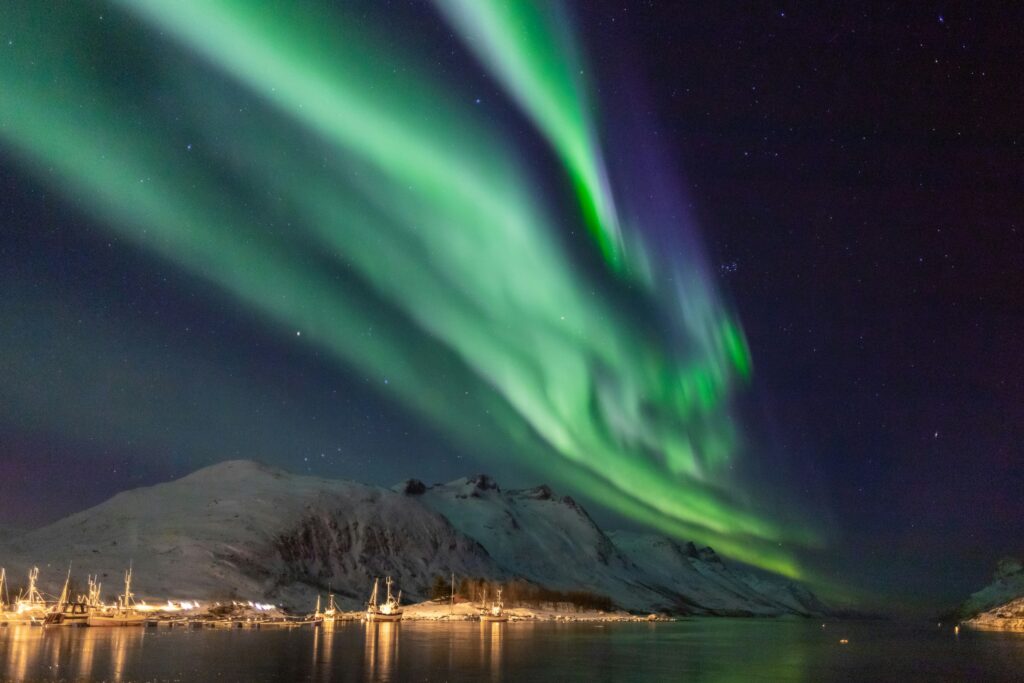
Norway edges out Iceland for sheer reliability. Cities like Tromsø sit directly under the auroral oval, meaning the lights appear regularly even during moderate solar activity. Combine that with Norway’s famous hygge culture, and you’ve got comfort alongside adventure.
Top Norwegian Aurora Destinations
Tromsø earned its nickname “Gateway to the Arctic” honestly. This vibrant city of 75,000 offers everything from aurora safaris to dog sledding, reindeer encounters, and winter fjord cruises. The city itself has surprisingly sophisticated restaurants, craft breweries, and cultural venues. Even on cloudy nights, you’ll find plenty to do.
Lofoten Islands deliver drama. Jagged granite peaks rise straight from the sea, traditional fishing villages cling to the shoreline, and the auroras dance above it all. The islands stay relatively mild thanks to the Gulf Stream, though winter still brings snow-covered peaks that create stunning contrast.
Alta holds the title of one of the world’s best aurora viewing spots, with clear skies about 200 nights per year. The Northern Lights Cathedral here features distinctive architecture inspired by the phenomenon. Nearby, the Sorrisniva Igloo Hotel offers a unique overnight experience.
Norwegian Culture and Practicalities
Norwegians value friluftsliv (open-air living), meaning you’ll find people embracing outdoor activities regardless of weather. English proficiency is nearly universal. The Norwegian krone (NOK) is the currency, with prices slightly higher than Iceland. Budget €120-180 per night for mid-range accommodation.
Norwegian cuisine features reindeer stew, fresh salmon, klippfisk (dried cod), and kvæfjordkake, a layered cake locals call “the world’s best.” Coffee culture runs deep, with Norwegians consuming more coffee per capita than almost anyone. Cafés double as workspaces where you can nurse a cappuccino for hours without judgment.
Getting There and Around
Fly into Tromsø Airport (TOS) via Oslo with SAS or Norwegian Air. Widerøe operates smaller planes connecting northern cities. Alternatively, Norway’s rail network is spectacular. The Bergen Line and Nordland Line offer scenic routes through fjords and mountains, though they don’t extend to the far north.
Within cities, buses run regularly. Between destinations, rental cars provide flexibility. In winter, studded tires are standard, making driving manageable even in snow.
Apps for Norway
Ruter and Entur handle public transit planning. Yr.no provides hyper-local weather forecasts developed by the Norwegian Meteorological Institute. For aurora predictions, stick with Aurora Forecast or Hello Aurora.
Finland: Silence, Snow, and Glass-Roofed Dreams
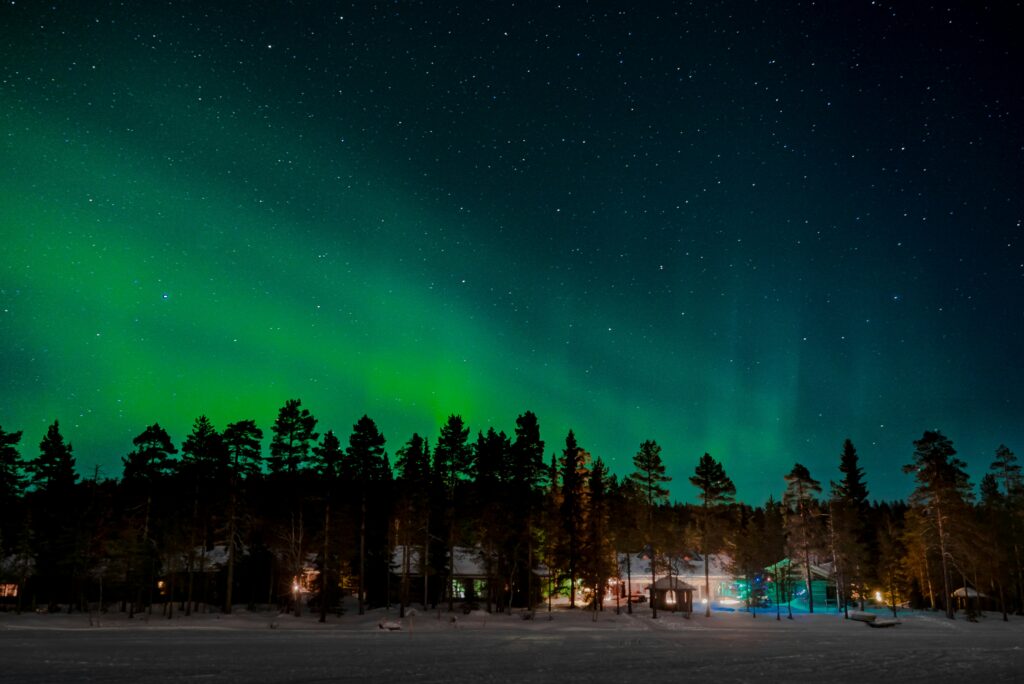
Finnish Lapland offers something unique: profound quiet. While Iceland and Norway deliver dramatic landscapes, Finland embraces minimalism. Endless forests, frozen lakes, and small villages create an atmosphere of peace that amplifies the aurora experience.
Best Finnish Aurora Spots
Rovaniemi serves as Lapland’s capital and the “official” home of Santa Claus. Beyond the Christmas tourism, it’s a genuine Arctic city with universities, museums, and excellent aurora viewing just outside the center. The Arktikum Museum provides fascinating context about Arctic life and indigenous Sami culture.
Kakslauttanen Arctic Resort pioneered the glass igloo concept. These geodesic domes let you watch the auroras from bed, heated and comfortable. While not cheap, they’ve become iconic for good reason. The resort also offers traditional log cabins and an ice restaurant.
Inari, in Finland’s far north, borders Europe’s largest lake. The area remains wild and remote, perfect if you’re seeking solitude. The Siida Museum here documents Sami history and Arctic nature through excellent exhibits.
Finnish Culture and Daily Life
Finns value personal space and quiet, but don’t mistake reserve for unfriendliness. Once you break the ice (sometimes literally), they’re warm and genuine. English is widely spoken, especially among younger generations. Finland uses the euro (EUR), with prices comparable to other Nordic countries.
Finnish food centers on game meats (reindeer, elk), freshwater fish, berries, and rye bread. Try karjalanpiirakka (Karelian pastries) and leipäjuusto (squeaky cheese) served with cloudberry jam.
Sauna culture is sacred. Every accommodation has one, and locals sauna multiple times weekly year-round. Accept any sauna invitation you receive; it’s where real conversations happen.
Travel Logistics
Fly into Helsinki-Vantaa Airport (HEL), then catch a domestic flight to Rovaniemi (RVN) or Ivalo (IVL) with Finnair or Norwegian. The overnight Santa Claus Express train from Helsinki to Rovaniemi offers a romantic alternative, complete with sleeper cabins and restaurant cars.
Digital Nomad Considerations
Finland’s infrastructure is exceptional. Even remote Lapland villages have reliable fiber internet. Coworking spaces exist in Rovaniemi, or simply work from cafés. WIFI.fi is a national public WiFi network available in many locations.
Time zone (EET/EEST) aligns well with European business hours. If working with American teams, expect early morning or late evening calls.
Accommodation Options
Glass igloos at Levin Iglut, Northern Lights Village, or Kakslauttanen range from €300-600 per night. Traditional hotels in Rovaniemi start around €100. For budget travelers, hostels like Hostel Café Koti offer dorm beds from €30.
What to Pack: Surviving Arctic Temperatures
Temperatures commonly drop to -20°C (-4°F), with extremes reaching -40°C (-40°F). Proper clothing isn’t optional.
Layering system: Start with merino wool or synthetic base layers that wick moisture. Add fleece or down mid-layers. Top with a waterproof, windproof shell. Brands like Icebreaker, Patagonia, and Arc’teryx make reliable options, but you don’t need premium gear. Decathlon and Uniqlo offer affordable alternatives.
Extremities matter most: Invest in quality insulated boots rated to -40°C (Sorel, Kamik). Bring wool socks and liner socks. Use lobster-claw gloves over liner gloves for photography. A balaclava or neck gaiter protects your face from windburn.
Photography equipment: Your DSLR or mirrorless camera needs a sturdy tripod. Cold drains batteries fast, so carry 4-5 spares kept warm in inner pockets. Bring lens wipes and hand warmers. A remote shutter release prevents camera shake during long exposures.
Many destinations offer equipment rentals if you don’t want to buy. Tromsø and Rovaniemi have outdoor shops renting complete winter clothing kits for €30-50 per day.
Capturing the Aurora: Photography Essentials
Photographing auroras challenges even experienced photographers, but it’s entirely achievable with preparation.
Camera settings: Shoot in manual mode with RAW format. Start with ISO 1600, aperture f/2.8 (or widest available), and 5-10 second exposure. Adjust based on aurora brightness and movement. Fast auroras need shorter exposures; faint auroras need longer.
Focus: Switch to manual focus and set to infinity. Better yet, use live view to focus on a bright star, then don’t touch the focus ring again.
Composition: Include foreground elements like trees, mountains, or buildings for scale and interest. The aurora alone often looks less impressive than when anchored by landscape.
Apps: PhotoPills helps plan shots using augmented reality to predict aurora position. Star Walk 2 identifies constellations. Aurora Forecast shows KP index predictions.
If you’re serious about aurora photography, check out detailed tutorials at Capture the Atlas or Lonely Speck. Both offer comprehensive guides free online.
Apps That’ll Make Your Trip Easier
Aurora prediction: My Aurora Forecast (iOS/Android), Aurora Alerts, Hello Aurora
Weather: Windy (incredibly detailed forecasts), Yr.no (Norway), Vedur.is (Iceland)
Navigation: Maps.me (offline maps crucial for remote areas), Google Maps
Translation: Google Translate works surprisingly well offline if you download language packs
Currency: XE Currency, Revolut (also offers fee-free ATM withdrawals and great exchange rates)
Accommodation: Booking.com, Airbnb, HostelWorld
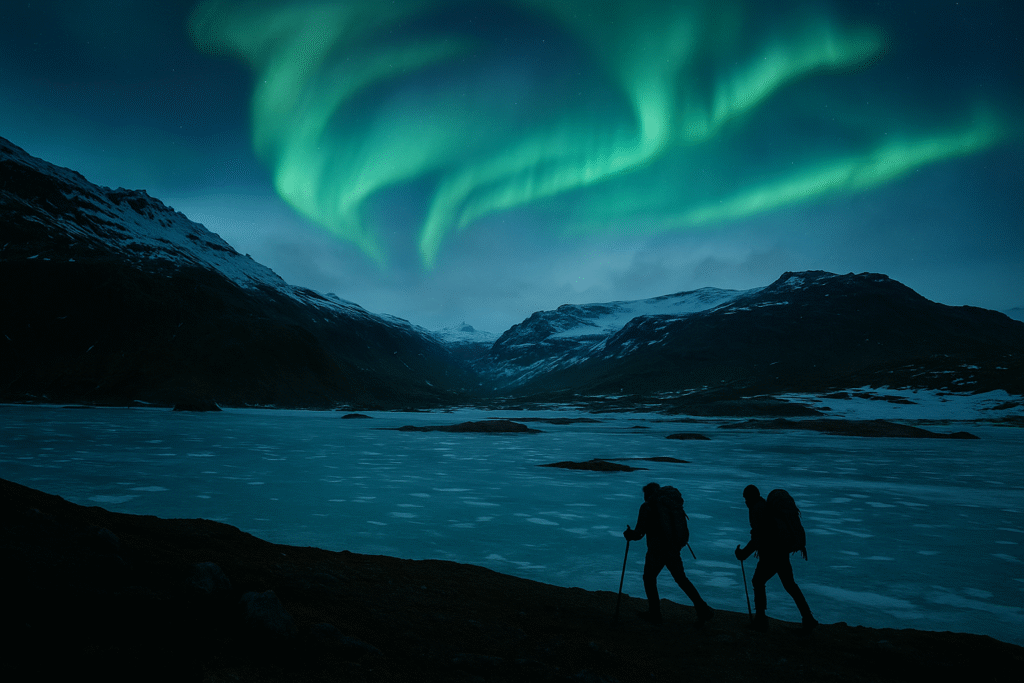
Budget Planning: What Will This Cost?
Aurora trips aren’t cheap, but they’re manageable with planning.
Flights:
- From Europe: €150-350 roundtrip to Oslo, Helsinki, or Reykjavík
- From North America: €300-600 roundtrip (watch for Iceland stopover deals)
- From Asia: €500-800 roundtrip
Accommodation: €80-300 per night depending on style. Hostels and Airbnbs at the low end, glass igloos at the high end.
Daily expenses: €100-200 covering meals (€15-30 per meal), local transport, and activities.
Tours: Aurora tours run €80-150 per person. Dog sledding €150-200. Snowmobile safaris €120-180.
Total for one week: Budget €1,500-3,000 per person for a comfortable experience including flights, accommodation, food, and activities.
Money-Saving Tips
Book flights 3-4 months ahead for best prices. Travel in September or March when accommodation costs less. Cook some meals if staying in places with kitchens. Join group tours rather than private ones. Consider less famous destinations like Swedish Kiruna or Canadian Yellowknife for similar experiences at lower costs.
Beyond Aurora Watching: Winter Activities
Most visitors quickly realize that aurora hunting involves a lot of waiting. Smart travelers fill daylight hours with activities.
Dog sledding through snowy forests offers an unforgettable connection with animals bred for Arctic conditions. Most tours include visits to kennels where you’ll meet dozens of enthusiastic huskies.
Reindeer experiences with indigenous Sami families provide cultural insights alongside the chance to try traditional driving and hear joik singing.
Snowmobiling tours range from short evening rides to multi-day Arctic expeditions. No previous experience necessary.
Ice fishing teaches patience while you wait for arctic char or trout. Locals take this seriously, but tour operators make it accessible and surprisingly meditative.
Cross-country skiing is the Nordic pastime. Trails are meticulously maintained and often lit for evening skiing.
Book activities through reputable operators like Arctic Adventures (Iceland), Tromso Arctic Reindeer (Norway), or Safartica (Finland). GetYourGuide and Viator aggregate options with verified reviews.
Understanding Indigenous Sami Culture
The Sami people have inhabited the Arctic regions of Norway, Sweden, Finland, and Russia for thousands of years. Respectful travelers take time to learn about their culture, which remains vibrant today.
Visit the Siida Museum in Inari, Finland, or the Sami Parliament in Karasjok, Norway. Several families offer authentic cultural experiences including traditional meals, storytelling, and demonstrations of handicrafts like knife-making and leatherwork.
The Sami have faced historical discrimination and ongoing challenges regarding land rights. Approach cultural experiences with respect and awareness that you’re guests in their homeland.
Safety Considerations
Arctic travel is generally safe, but nature demands respect.
Avalanche risk: Check local warnings before hiking. Stick to marked trails.
Extreme cold: Frostbite develops quickly. Watch for numbness in fingers, toes, nose, or ears. Seek warmth immediately if symptoms appear.
Wildlife: Moose cause more injuries than any other animal. Give them wide berth, especially in winter when they’re stressed. Brown bears hibernate during aurora season, so they’re not a concern.
Driving: Black ice is invisible and deadly. Drive slowly, brake gently, and allow triple the stopping distance you’d need in summer.
Communication: Remote areas may lack cell coverage. Download offline maps. Inform someone of your plans before heading into wilderness.
Iceland operates a fantastic system: text your travel plans to 112, and they’ll track your route. If you don’t check in at the expected time, they’ll initiate search and rescue. Learn more at SafeTravel.is.
For Digital Nomads: Working Under the Aurora
Extended stays offer better aurora odds while letting you maintain work routines.
Visa requirements: EU/EEA citizens can stay up to 90 days in Iceland, Norway, or Finland. Americans, Canadians, and many others get 90 days visa-free in the Schengen Area. For longer stays, investigate digital nomad visas (Norway launched one in 2024).
Internet reliability: Exceptional in all three countries. Even rural areas typically have 4G coverage. Coworking spaces exist in larger towns.
Time zones: Iceland (GMT), Norway and Finland (CET/CEST) work well with European clients. North American hours require evening work, but afternoons are free for activities.
Accommodation for long stays: Monthly Airbnb rentals offer better rates. Consider Rovaniemi, Akureyri, or Tromsø for balance between aurora access and urban amenities.
Community: Expat and digital nomad groups exist in larger cities. Check Facebook groups or Meetup.com for social opportunities.
Alternative Destinations Worth Considering
While Iceland, Norway, and Finland dominate aurora tourism, other locations offer excellent viewing with fewer crowds.
Swedish Lapland: Kiruna and Abisko offer some of Earth’s clearest skies due to unique microclimates. The Abisko National Park claims 70% clear night rates in winter.
Canada: Yellowknife in the Northwest Territories sits directly under the auroral oval. Whitehorse, Yukon, combines aurora viewing with gold rush history.
Alaska: Fairbanks delivers consistent auroras with American convenience. The University of Alaska’s Geophysical Institute provides excellent forecasts.
Scotland: Yes, really. During strong solar storms, auroras appear over the Highlands and Northern Isles. It’s far less reliable but combines easily with other UK travel.
Greenland: For true adventure seekers, Greenland offers pristine wilderness and minimal light pollution. Infrastructure is limited, making this an expedition rather than a vacation.
Making It Happen: Planning Timeline
6-8 months ahead: Research destinations based on your budget and interests. Book flights during sales. Consider trip insurance that covers weather-related cancellations.
3-4 months ahead: Reserve accommodation, especially glass igloos or popular hotels. Book any specialized tours like dog sledding or ice hotels.
1-2 months ahead: Purchase cold-weather gear. Download apps and create accounts. Research photography techniques. Check visa requirements and ensure passports have six months validity.
2 weeks ahead: Check extended weather forecasts. Join aurora alert groups on Facebook for your destination. Confirm all bookings. Break in new boots if you bought them.
Upon arrival: Buy local SIM card for data (often cheaper than roaming). Adjust expectations about aurora viewing (some trips see nothing despite perfect planning). Embrace flexibility.
The Real Magic
Here’s what no guide can fully convey: witnessing the aurora changes something in you. It’s not just the visual spectacle, though that alone justifies the effort. It’s standing in profound cold and darkness, watching light dance according to rules you don’t control or understand, and feeling simultaneously insignificant and deeply connected to something vast.
I’ve seen travelers cry. I’ve watched stoic Norwegians gasp like children. I’ve stood in -30°C cold for three hours and never once thought about going inside.
The aurora doesn’t care about your camera settings or your travel plans. It appears when conditions align, performs its ancient dance, and fades. You can’t summon it, purchase it, or guarantee it. You can only prepare, position yourself properly, and wait.
That’s the gift, really. In our age of instant everything, the aurora teaches patience. It rewards those willing to endure cold and darkness for something that might not materialize at all. And when it does appear, when those ribbons of light finally unfurl overhead, you’ll understand why humans have been chasing them for thousands of years.
The Northern Lights aren’t just a bucket list item to check off. They’re a reminder that the world still holds wonders no screen can capture, experiences that demand your physical presence in specific places at specific times. In that way, aurora hunting becomes a perfect metaphor for travel itself: uncertain, sometimes uncomfortable, always worth it.
So bundle up, check that aurora forecast, and head north. The lights are waiting.
Related Post: Winter Travel: Top Destinations for Snowy Getaways
